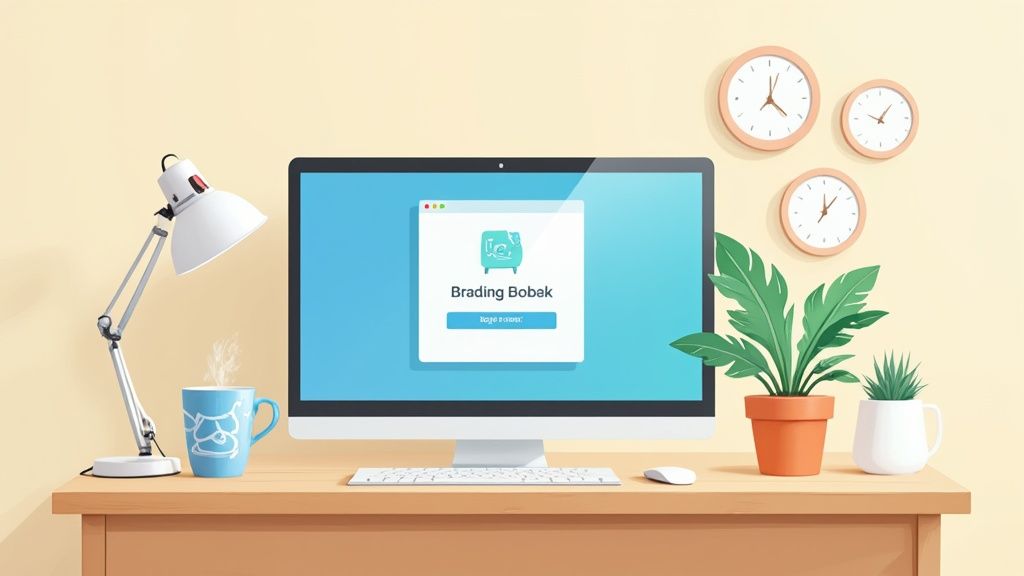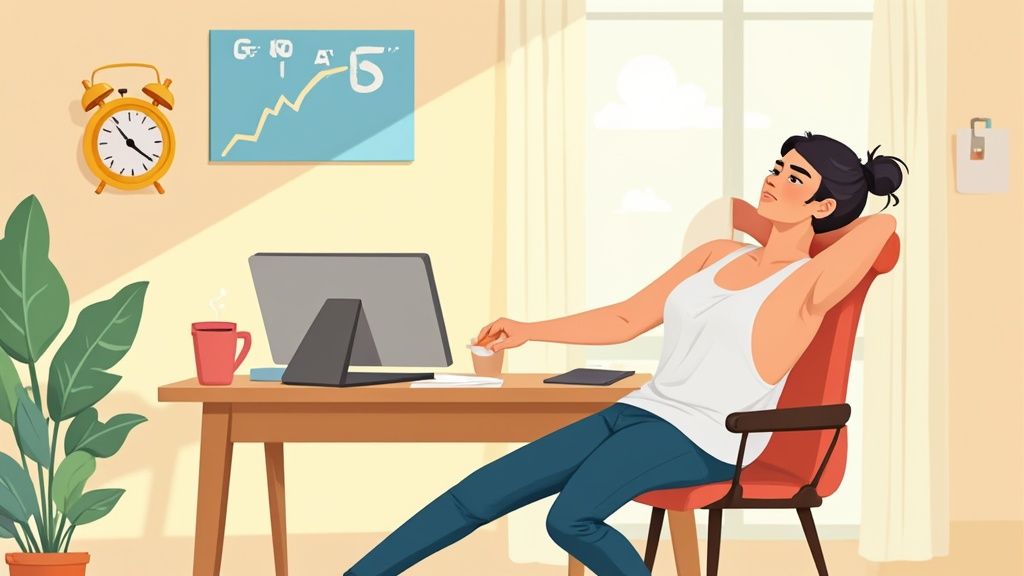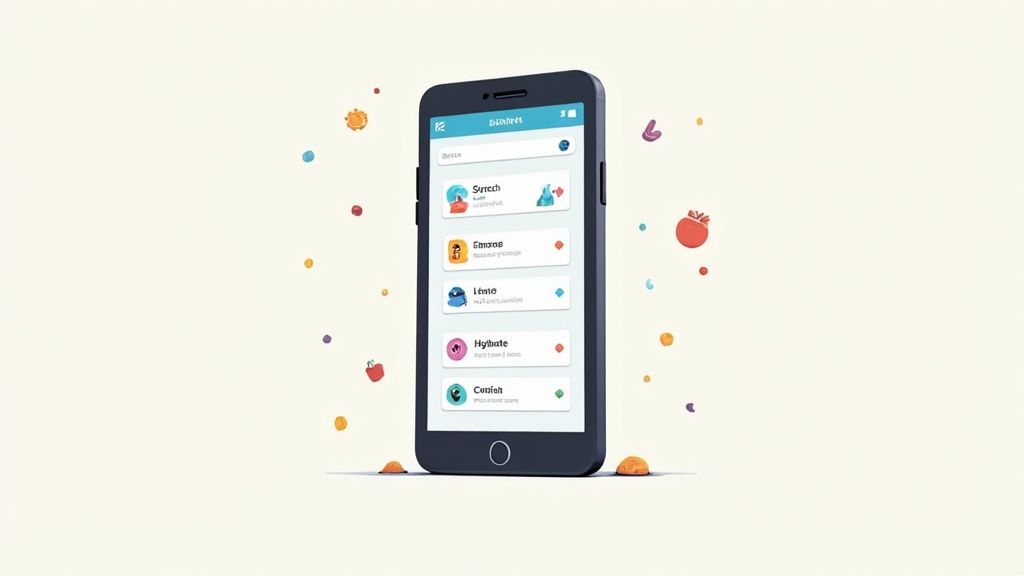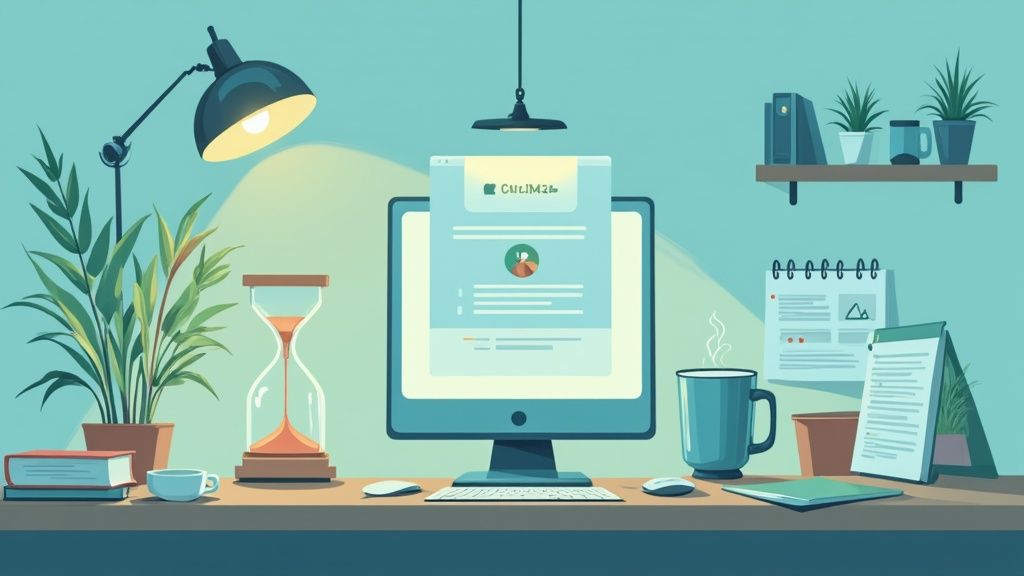Break Reminder App Guide: Smart Strategies for Peak Productivity
The Evolution of Smart Break Management

Taking breaks has been part of work for generations, but how we approach them has changed dramatically over time. In the past, breaks were simple pauses marked by lunch bells or shift changes, with little thought given to personal needs or productivity science. The rigid 9-to-5 schedule and random breaks didn't help people work at their best.
From Basic Timers to Smart Apps
When technology first entered the workplace, simple timers were the earliest break tools. While an improvement, these basic reminders had clear limitations - they couldn't adjust break timing or type based on different activities. A timer might interrupt deep work with a 30-minute break, or suggest too short a pause after hours of screen time. Better solutions were clearly needed.
Break reminder apps emerged as the solution, bringing smart features like custom schedules, activity suggestions, and connections to other work tools. This shift made break management more personal and data-driven. Users can now shape their break patterns around their own work styles and energy levels for better results.
The Science of Effective Breaks
Modern break apps rely heavily on research into how breaks affect productivity and wellbeing. They incorporate proven concepts like the 20-20-20 rule for eye strain and the Pomodoro Technique for focused work. Top professionals now use these science-backed tools to maintain high performance.
Studies confirm that sitting too long harms both body and mind, causing low energy, muscle problems, and fuzzy thinking. A break reminder app prompts movement to boost blood flow and mental clarity. It can also prevent decision fatigue - that mental drain from making choices all day. Taking strategic breaks lets your mind reset and tackle tasks with fresh focus.
The Future of Break Management
Break reminder apps keep getting better with new capabilities. They now connect with wearable devices and provide personalized activity recommendations using your data. Rather than just reminding you to pause, these apps are becoming smart productivity partners that help you work better, not longer. As the technology improves, we'll see even more ways to tailor breaks for peak performance while protecting our health.
Building Your Perfect Break Reminder System

Taking breaks effectively requires more than just setting basic timers. A good break reminder system adapts to how you work and helps you take breaks in a way that fits your style. This means having control over when you take breaks, how you're reminded about them, and what activities you do during those pauses.
Customizing Notifications and Intervals for Optimal Flow
The way you receive break reminders makes a big difference in their effectiveness. Harsh alarms can disrupt your concentration and throw off your workflow. Instead, focus on gentler options like soft desktop notifications, visual indicators, or calming sounds that signal break time without jarring you out of focus. Some apps let you pick from different reminder styles - from subtle notifications to full-screen prompts - so you can find what works best for you.
Break timing also needs to match your personal work rhythm. The standard "break every hour" approach doesn't fit everyone's needs. Some people work better with frequent 5-minute breaks, while others prefer longer breaks spaced further apart. Good break reminder tools give you flexibility to adjust intervals based on your preferences and the type of work you're doing. You might try the popular Pomodoro method of 25 minutes of work followed by 5-minute breaks, or experiment with other patterns like 52 minutes of work and 17 minutes of rest.
Integrating Activity Suggestions for Enhanced Breaks
What you do during breaks matters just as much as when you take them. Simply stepping away from your desk isn't always enough - the best breaks include activities that help you recharge physically and mentally. This is where having break activity suggestions comes in handy. Good break reminder systems might prompt you to do quick stretches, eye exercises, breathing practices, or short walks. These targeted activities help prevent fatigue from long periods of computer use. For example, you could follow the 20-20-20 rule (looking at something 20 feet away for 20 seconds every 20 minutes) to reduce eye strain, or do desk stretches to ease back tension.
Combining Features for a Personalized System
The most effective break reminder systems bring these elements together based on your needs. If you're in a busy office role, you might prefer quiet notifications for quick movement breaks throughout the day, with stronger reminders for longer breaks focused on exercise or mindfulness. Creative professionals might benefit from longer, less frequent breaks that include activities like sketching or free writing. The key is testing different combinations of reminder styles, timing patterns, and break activities to find what helps you stay energized and productive. By thoughtfully mixing these features, your break reminder system can help you maintain focus, boost energy levels, and create better balance in your workday.
Mastering the Art of Strategic Breaks

A break reminder app is much more than a simple timer - it's a tool that can help you take better breaks and work smarter. Learning how to take effective breaks is a skill that requires understanding the right timing, activities, and transitions back to work. Let's explore how to make the most of your breaks to stay focused and refreshed throughout the day.
Timing Your Breaks for Maximum Impact
When it comes to breaks, timing is everything. Instead of sticking to a rigid schedule, pay attention to your own energy patterns and the type of work you're doing. Deep focused work may benefit from shorter 5-minute breaks every 25 minutes using the Pomodoro Technique. Creative tasks often work better with longer breaks spaced further apart to maintain your flow state. Use your break reminder app to experiment and find the intervals that help you stay most productive.
Activities for Optimal Cognitive Refreshment
What you do during your breaks matters just as much as when you take them. Simply stepping away from your computer isn't always enough - you need activities that actively recharge your mind and body. A good break reminder app will suggest options like quick exercises, mindfulness practices, and creative activities that match your needs. Choose activities that let you return to work feeling mentally refreshed and ready to tackle challenging tasks.
Returning to Deep Work Without Losing Momentum
One challenge with taking breaks is smoothly transitioning back into focused work afterward. A well-designed break can actually help you regain focus faster. Use your break reminder app to give you gentle alerts when break time is ending. Before resuming work, take a moment to review your task list or outline your next steps. This brief planning helps minimize the time needed to get back into a productive flow state.
Adapting Your Break Schedule to Different Work Types
Different kinds of work require different break strategies. Detail-oriented analytical tasks may need frequent short breaks for eye exercises and stretching. Creative projects often benefit from longer breaks that allow your mind to wander and find inspiration. A break reminder app lets you customize break prompts based on your current work. Pay attention to which break patterns work best for different activities and adjust accordingly. Making strategic use of breaks throughout your day leads to better focus, creativity and results.
Taking Control of Your Work Through Data

A good break reminder app does more than just send notifications - it helps you understand and improve your work habits through meaningful data. By tracking your screen time, break patterns, and activity levels throughout the day, these apps provide valuable insights into how you actually work. When you analyze this information, you can make smarter decisions about managing your time and energy.
Making Sense of Your Work Patterns
Break reminder apps collect data about when and how you work - from screen time and break frequency to the types of activities you do during breaks. This information reveals important patterns about your productivity. For example, you might discover that you consistently get more done in the morning hours but struggle to focus after lunch. With these insights, you can schedule challenging tasks during your peak times and lighter work when your energy naturally dips. The data may also show whether shorter, frequent breaks help you stay more productive than longer, infrequent ones.
Finding Your Peak Performance Times
The data from your break reminder app can help identify your natural energy cycles throughout the day. When you compare your break patterns with your work output, clear patterns emerge about when you're most and least productive. This knowledge is key for planning your schedule effectively. For instance, if your data shows an afternoon energy slump, you can plan to take an energizing walk break at that time instead of pushing through with diminishing returns. Understanding these patterns lets you work with your natural rhythms rather than against them.
Using Data to Set Better Goals
One of the biggest advantages of a break reminder app is getting an accurate baseline of your current work habits. Rather than setting arbitrary goals, you can use real data to make achievable plans for improvement. For example, if your app shows you average five focused hours per day, aiming for six hours next week is realistic. This measured approach based on data helps prevent burnout from overly ambitious targets while still moving you forward. The app's tracking features also provide concrete evidence of your progress over time.
Making Smart Changes to Your Workday
The insights from your break reminder app can guide meaningful improvements to how you work. For instance, the data might reveal that you spend excessive time on social media or in unproductive meetings. Armed with this knowledge, you can set specific limits on distracting apps or restructure meeting schedules. You can also experiment with different break activities - maybe a quick meditation helps you refocus better than browsing the internet. Having data to inform these decisions leads to more effective and sustainable work habits than relying on guesswork alone.
Overcoming Break Management Obstacles
Taking regular breaks seems simple, but putting it into practice can be challenging. Between tight deadlines, back-to-back meetings, and workplace pressures, many of us feel guilty about stepping away from our desks, even briefly. While these concerns are natural, maintaining healthy break habits is essential for sustainable productivity. Let's examine the most common hurdles to taking breaks and practical ways to overcome them.
Managing Deadline Pressure
When racing to meet deadlines, taking breaks might feel counterproductive. However, research consistently shows that short pauses actually boost output and focus. Think of your brain like any other muscle - it needs recovery periods to perform at its peak. Using a break reminder app can help maintain this balance, even during crunch time. For example, following the Pomodoro Technique with 5-minute breaks every 25 minutes can significantly improve concentration and work quality.
Handling Meeting-Heavy Days
Finding break opportunities can be especially tricky when your calendar is packed with meetings. The key is treating breaks like any other important appointment. Block off short break periods in your schedule and protect that time. During longer meetings, suggest brief stretch breaks after an hour - this benefits everyone involved. A break reminder app can subtly prompt you to propose these pauses, ensuring the whole team gets needed rest.
Shifting Team Culture
Sometimes the pressure to work non-stop comes from unspoken team expectations. If everyone seems constantly busy, taking breaks might feel like slacking off. The solution is open communication about how breaks boost productivity and work quality. Share relevant research with colleagues and lead by example by visibly taking your own breaks. As more team members adopt healthy break habits, it becomes part of the workplace culture.
Creating Lasting Break Habits
Building sustainable break routines requires consistent practice. A break reminder app can help establish and maintain your schedule. Start small with 5-10 minute breaks and gradually increase duration as it becomes more natural. Experiment to find break activities that leave you refreshed - some days a quick walk works best, other times meditation might be ideal. The important part is sticking to your break schedule, even during busy periods. With time, taking regular breaks becomes automatic, improving your focus, output and overall wellbeing. The right break reminder app helps protect these essential pauses against workplace pressures.
Innovations in Break Management Technology
Break reminder apps have grown far beyond simple timers. Over the years, these tools have evolved to support our wellbeing based on research showing how strategic breaks boost focus, creativity, and energy levels while preventing exhaustion. Here are the key advances improving how we take breaks at work:
AI-Powered Personalization
One major advancement is the integration of artificial intelligence into break reminders. Modern apps analyze your work patterns - including typing speed, mouse movement, and program usage - to suggest optimal break timing just for you. Rather than a rigid schedule, the app adapts to your natural rhythms. For instance, after an intense focus session, it may recommend unwinding with mindfulness. Following lighter tasks, it might suggest brief stretching instead. This personalized approach helps ensure breaks give you the recharge you really need.
Biometric Integration
Break apps now connect to wearables like smartwatches to track physical signals of stress, including heart rate variability (HRV). With real-time data about your mental and physical state, the app can prompt breaks when you need them most. If your HRV shows high stress, you might get a reminder to take a few deep breaths or walk around. These biometric insights help prevent overwork before exhaustion sets in.
Gamification and Engagement
To make break-taking more enjoyable and consistent, apps incorporate game elements like challenges, rewards and progress tracking. You might earn points for completing break activities, unlock new features, or engage in friendly competition with colleagues. Making breaks both fun and purposeful increases the likelihood that users will stick with healthy break habits long-term.
Integration with Other Productivity Tools
Break reminders now work seamlessly with your other work tools, fitting naturally into your workflow. Apps can coordinate with your calendar to schedule breaks around meetings and deadlines. Some connect to project management platforms to suggest breaks based on task completion. This integration ensures breaks enhance rather than disrupt your productivity, helping you maintain both focus and freshness throughout the day.
Moova offers a comprehensive solution to integrate short, effective activity breaks into your daily routine. Combat the negative effects of prolonged sitting and improve your well-being with over 200 expertly crafted exercises. Start building healthier habits today! Download Moova now: https://getmoova.app







